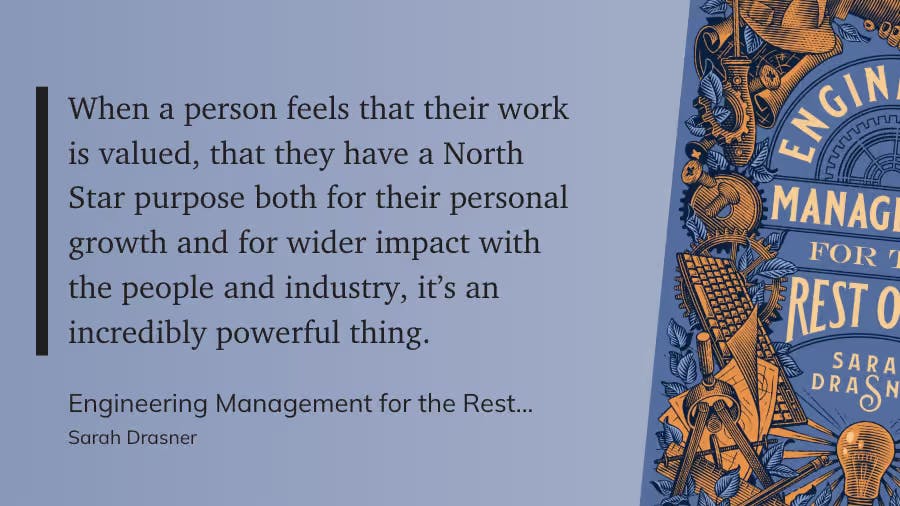

- 🚀 The Book in 3 Sentences
- 🎨 Impressions of Engineering Management
- ☘️ How the Book Changed Me
- 📒 Summary + Notes
🚀 The Book in 3 Sentences
"Effective Management and Leadership: A Guide to Communication, Goal Setting, and Self-Care" offers managers and leaders a thorough manual for enhancing their communication, goal-setting, and self-care abilities. It focuses on the significance of values in management and leadership and offers a thorough guide to goal-setting and prioritization. Reading this book will equip you with the skills necessary to motivate and inspire your team while also looking after yourself. You can find more at https://www.engmanagement.dev/.
🎨 Impressions of Engineering Management
How I Discovered It
When the vast majority of the developers I follow in Twitter started sharing the release information of this book, I realized I needed to take a look. As a Developer Advocate, I am often reviewing my career path in light of both what engineers use AND community management that sits within a marketing department. I wanted to glean the insights of where I hope to be career-wise within several years.
Who Should Read It?
Whether you are an engineer, developer advocate, community management, on a career path to become any one of these, or a manager of these roles, you’ll want to read and reread this book. I would also suggest that team leaders, project managers, and supervisors will find it especially helpful. If you want to learn about effective management and leadership techniques as well as the significance of values in management and leadership, get your copy now.
☘️ How the Book Changed Me
- Clear set of values that guide managers' and leaders' actions and decisions. Become more aligned with their team and to develop a sense of purpose and direction.
- Clear communication in management and leadership: It includes strategies for encouraging team members to share their thoughts and ideas and for fostering open communication.
- Self-care for managers and leaders: The book emphasizes the importance of self-care for managers and leaders, as it can help to prevent burnout and ensure that they can perform at their best. It includes self-care advice such as setting boundaries.
- The importance of effective goal setting and prioritization: The book provides detailed guidance on how to set and achieve goals, as well as prioritize tasks and projects. It demonstrates how effective goal setting and prioritization can lead to improved performance and greater team success.
- Have a code of conduct that specifies what type of behavior is acceptable and what is not.
- The significance of assuming good intentions and not closing a PR from an active contributor and reimplementing the same thing yourself.
- Active participation in peer and mob programming: team members sharing their thinking through a problem, as well as wins and mistakes.
- Fostering psychological safety: a positive developer experience, and a sense of alignment with the company's goals.
- When making decisions, it is necessary to check in with facts, find and rally around the positive, reject negative premises, and consider the consequences.
✍️ My Top 3 Quotes
When a person feels that their work is valued, that they have a North Star purpose both for their personal growth and for wider impact with the people and industry, it’s an incredibly powerful thing.
Building a team where a group of people from diverse backgrounds, cultures, and lived experiences can thrive is how we create healthy working environments.
A team that’s motivated, has psychological safety with you and among themselves, has good developer experience within their tech stack, and feels aligned with the company’s goals will always perform better than one that isn’t.
📒 Summary + Notes
Good engineering management necessitates knowledge of power dynamics, organizational structures, and broad-based approaches. The necessity of fostering a positive team culture and a set of shared values is also emphasized. These factors can increase performance and create trust. The paragraph also emphasizes the significance of good teamwork and problem-solving, as well as the necessity for managers to assume accountability for putting their people in a position to succeed and keeping a positive attitude.
Clear communication, establishing and enforcing boundaries, and promoting a healthy and productive work atmosphere are all necessary for effective management and leadership. This entails giving justifications for denying or rejecting help requests, upholding a code of conduct, presuming goodwill, handling conflicts, and establishing specific objectives and timeframes. It also highlights the value of managers' and leaders' self-awareness and self-care, as well as the relevance of self-confidence and self-efficacy in attaining success. The paragraph also makes the case that minimizing technical debt and placing more emphasis on the system than on individual objectives may be beneficial for team success.
- Introduction
- Engineering management requires understanding power imbalances and people structures
- Importance of considering strategies outside of a single project
- The Role of Values
- Values as fundamental beliefs that guide actions and determine what is important
- Values provide context for understanding a person's mental state, needs, and motivations
- Sharing values can build trust and vulnerability within a team
- Core values help companies determine goals and create a stable direction forward
- Building a Positive Team Culture
- Regular team check-ins and discussions are important for success
- Manager's role in setting team up for success and maintaining morale
- Importance of alignment, challenging work, sense of togetherness, and fair treatment for achieving flow state
- Importance of connection and positive reinforcement in times of stress
- Effective Communication and Problem-Solving
- Importance of hearing feelings and needs behind a message
- Peer and mob programming for sharing thinking and learning from mistakes
- Checking facts, finding and rallying around the positive, rejecting negative premises, and reviewing consequences
- Stepping away from volatile situations as a manager
- Communication and Collaboration
- Explain reasons for closing or declining help requests
- Provide a code of conduct for acceptable behavior
- Assume good intentions in confusion
- Avoid closing PRs and re-implementing the same thing
- Address and resolve personal conflicts
- Goal Setting and Prioritization
- Objectives should be high-level goals that inspire a picture of the future
- Values provide context for understanding a person's mental state, needs, and motivations
- Sharing values can build trust and vulnerability within a team
- Core values help companies determine goals and create a stable direction forward
- Key Results are specific measurable pieces of data over time
- Define future OKRs by looking forward and backward
- Prioritize and make decisions that are right for you
- Team Management and Performance
- Regular team check-ins and discussions are important for success
- Manager's role in setting team up for success and maintaining morale
- Saying no to give team bandwidth and space for what is critical
- Keep track of unfinished work for stakeholders
- A motivated, psychologically safe, and aligned team will perform better
- Avoid splitting engineers

Engineering Management for the Rest of Us
Sarah Drasner
November 1, 2022
A lot of Engineering Managers and leaders studied for years and years to become the best Engineer they possibly could be... and then they were promoted. It can be very tough for those of us who didn't go into Engineering with the distinct concept that we would become managers, but still want to do our best to support our teams. I wrote this book because there's so much no one told me about management that I wished I would have known. There's a lot to be purposeful about that many of us learn on the job, and worse: learn on people. This book provides some organization for collaborating with networks of people, working together towards a common purpose. There seem to be millions of articles and "how to"s on programming and only a handful of resources on Engineering Management- why? It's very tough to talk about something that involves people processes. People are non-deterministic. Working relationships are nuanced, communication is linked with individual values, motivations, power dynamics, and skills. People also have a range of experiences and emotions that are not consistent day-to-day. Hopefully, in the happiest, most productive sense. It's imperative that we as managers learn as much as we can and work on ourselves, so that our teams may enjoy a healthy working life and strong relationships. It's not just important, it's crucial that we iterate on our own skills as managers so that we can properly support everyone around us: individuals, peers, leadership, and the business. I'm sharing what I've learned- not so that you follow my concepts exactly, but rather so that you can be thoughtful about your own leadership and needs. The book goes from the macro to the micro- with topics ranging everywhere from "feedback" to "scoping down PRs". Though the book is meant to address people in management, individual contributors are welcome to read the book as well- perhaps you need to manage up and need some tools to help guide the conversation, perhaps you just want a peek at other concerns within the business- everyone is invited to the conversation.
This article first appeared on:
Courtney Robertson -
by




